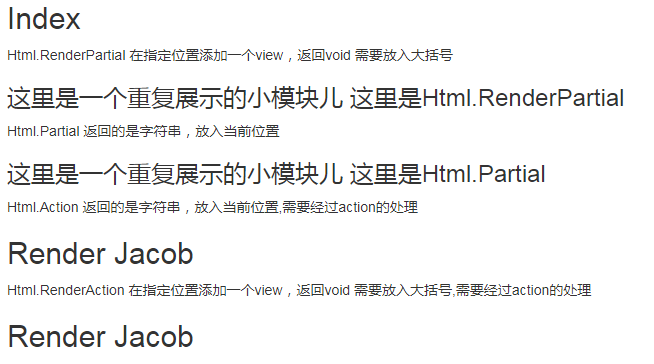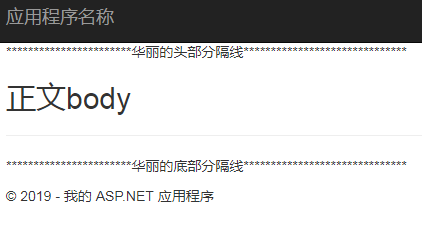MVC项目中多个页面有相同的东西,框架中提供了几种解决方案: partialView,Layout,section
一、partialView分布页
1用户控件axcs——partial:重复的小模块


<div> <p>Html.RenderPartial 在指定位置添加一个view,返回void 需要放入大括号 </p> @{Html.RenderPartial("PartialPage", "这里是Html.RenderPartial");} </div> <div> <p>Html.Partial 返回的是字符串,放入当前位置</p> @Html.Partial("PartialPage", "这里是Html.Partial") </div> <div> <p>Html.Action 返回的是字符串,放入当前位置,需要经过action的处理</p> @Html.Action("Render", "Third", new { name = "Html.Action" }) </div> <div> <p>Html.RenderAction 在指定位置添加一个view,返回void 需要放入大括号,需要经过action的处理</p> @{Html.RenderAction("Render", "Third", new { name = "Html.RenderAction" });} </div>


@{ ViewBag.Title = "PartialPage"; Layout = null; } <h3>这里是一个重复展示的小模块儿 @Model</h3>


[ChildActionOnly]//不能被单独请求 public ActionResult Render() { this.ViewBag.Name = "Jacob"; return View(); //return PartialView() //指定分部视图,在_ViewStatrt.cshtml中指定的Layout会无效 }


@{ ViewBag.Title = "Render"; Layout = null; } <h2>Render @ViewBag.Name</h2>
执行页面效果如图:

二、Layout布局页
master——Layout布局页
MVC项目中如果不写布局页,默认布局页为 Layout = "~/View/Shared/_Layout.cshtml";
我们写在cshtml的代码会出现在@RenderBody()的位置上


<!DOCTYPE html> <html> <head> <meta http-equiv="Content-Type" content="text/html; charset=utf-8" /> <meta charset="utf-8" /> <meta name="viewport" content="width=device-width, initial-scale=1.0"> <title>@ViewBag.Title - 我的 ASP.NET 应用程序</title> @Styles.Render("~/Content/css") @Scripts.Render("~/bundles/modernizr") </head> <body> <div class="navbar navbar-inverse navbar-fixed-top"> <div class="container"> <div class="navbar-header"> <button type="button" class="navbar-toggle" data-toggle="collapse" data-target=".navbar-collapse"> </button> @Html.ActionLink("应用程序名称", "Index", "Home", new { area = "" }, new { @class = "navbar-brand" }) </div> </div> </div> <div class="container body-content"> <p> ***********************华丽的头部分隔线****************************** </p> @RenderBody() <hr /> <footer> <p>***********************华丽的底部分隔线******************************</p> <p>© @DateTime.Now.Year - 我的 ASP.NET 应用程序</p> </footer> </div> </body> </html>
效果如下图:

三、Section
在具体的业务页面 写section节点代码


@section SectionName
{
SectionBody
}
在布局页里写有
@RenderSection(SectionName, required: false)
最终生成的页面里会将cshtml 对应Section节点 替换到layout页面代码上
required:true表示页面必须有该节点,false表示可以有可以没有
转载于:https://www.cnblogs.com/Dewumu/p/10458805.html
最后
以上就是粗心宝马最近收集整理的关于ASP.NET MVC Razor的全部内容,更多相关ASP.NET内容请搜索靠谱客的其他文章。
本图文内容来源于网友提供,作为学习参考使用,或来自网络收集整理,版权属于原作者所有。








发表评论 取消回复